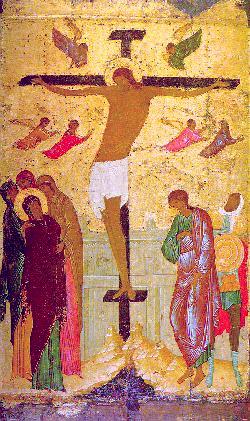
Dionisii, late 15th or early 16th century.
Tretyakov Gallery, Moscow, 85 x 52 cm.

 This icon, painted by Dionisii (Dionysius), represents the Crucifixion of Jesus, witnessed both by the host of heaven and the people of the earth: "Now when the centurion saw what was done, he glorified God, saying, Certainly this was a righteous man. And all the people that came together to that sight, beholding the things which were done, smote their breasts, and returned. And all his acquaintance, and the women that followed him from Galilee, stood afar off, beholding these things." (KJV, Luke 23: 47-49). Here, Jesus is again the central figure. This is emphasized by his placement in the picture plane, by the coloring of His flesh, garment, and the cross, and the fact that all the other figures are in some way responding to His presence. The elongated nature of Dionysius' figures also adds emphasis to the central position of Jesus. With arms wide open, He is shown as the willing sacrifice for humankind's sins and seems to be welcoming all to come and partake of the new life He is purchasing for all by His death. Above Him are two angels and below Him four. In the foreground are two clusters of people who are significantly contrasted with Jesus by the varied colors of their clothing. Mary stands to the left with a halo distinguishing her, while perhaps John the Apostle comforts her as recorded in the Gospel. The eyes of all of the human witnesses are either on Jesus or lowered in contemplation and mourning. The highlighted folds of drapery give depth and a degree of movement to the earthly figures, which makes them contrast with Jesus even more. To the right is another mourner, with head uncovered, and the centurion Longinus. His armor makes him stand out from the rest of the figures and his fixed gaze is a testimony to the compelling sacrifice of Jesus.
This icon, painted by Dionisii (Dionysius), represents the Crucifixion of Jesus, witnessed both by the host of heaven and the people of the earth: "Now when the centurion saw what was done, he glorified God, saying, Certainly this was a righteous man. And all the people that came together to that sight, beholding the things which were done, smote their breasts, and returned. And all his acquaintance, and the women that followed him from Galilee, stood afar off, beholding these things." (KJV, Luke 23: 47-49). Here, Jesus is again the central figure. This is emphasized by his placement in the picture plane, by the coloring of His flesh, garment, and the cross, and the fact that all the other figures are in some way responding to His presence. The elongated nature of Dionysius' figures also adds emphasis to the central position of Jesus. With arms wide open, He is shown as the willing sacrifice for humankind's sins and seems to be welcoming all to come and partake of the new life He is purchasing for all by His death. Above Him are two angels and below Him four. In the foreground are two clusters of people who are significantly contrasted with Jesus by the varied colors of their clothing. Mary stands to the left with a halo distinguishing her, while perhaps John the Apostle comforts her as recorded in the Gospel. The eyes of all of the human witnesses are either on Jesus or lowered in contemplation and mourning. The highlighted folds of drapery give depth and a degree of movement to the earthly figures, which makes them contrast with Jesus even more. To the right is another mourner, with head uncovered, and the centurion Longinus. His armor makes him stand out from the rest of the figures and his fixed gaze is a testimony to the compelling sacrifice of Jesus.
Because this icon theme (The Crucifixion) is one of the traditional festival icons, there are many examples with which to compare it.
One example, a Moscow School's work of the late 14th century (Andrei Rublev Museum in Moscow), simplifies the composition, presenting only three figures: Mary, Christ, and John. The color scheme is limited, with the emphasis placed on brown, beige, and and ochre-gold. Only the loincloth of Christ is rendered in an eye-catching pastel green. The cross stands on the top of a cave containing the skull of Adam (This is a symbolic allusion to the belief that Christ is the second Adam and to the legend that the Golgotha is a burial place of the first Adam). The overall compositional simplicity and excellence of the icon, as well as the deeply human expression of grief on Mary's face and of philosophical contemplation on John's, make this icon a masterpiece.
Another version, from the first half of the 16th century (shown above on the right), is very similar in composition to the work of Dionysius. However, it is clear that the master's icon has greater spiritual impact and an astonishing color scheme. The other icon appears to be just an average copy, not without merit, but failing to provide a strong spiritual stimulus through its regular composition and its unoriginal color scheme. Dionisii's Crucifixion seems to exist apart from its physical surroundings and thus delivers a more overt and emphatic spiritual message which speaks directly to the viewer. [B.B. and A.B.]
[Source: Grierson].
